Trying to decide where to knit or crochet? What you plan to make, skill level, and time available plays a big part in this decision. As a passionate
These two popular
In this blog post, I’ll be your guide as we unravel the differences between knitting and crochet. Together, we’ll explore the intricacies of these crafts, dive into their techniques and tools, examine the project possibilities they offer, and weigh the pros and cons of each. By the end, you’ll have a clearer understanding of these captivating crafts, empowering you to choose the one that suits your creative vision and personal preferences.
Whether you’re a curious beginner eager to start your
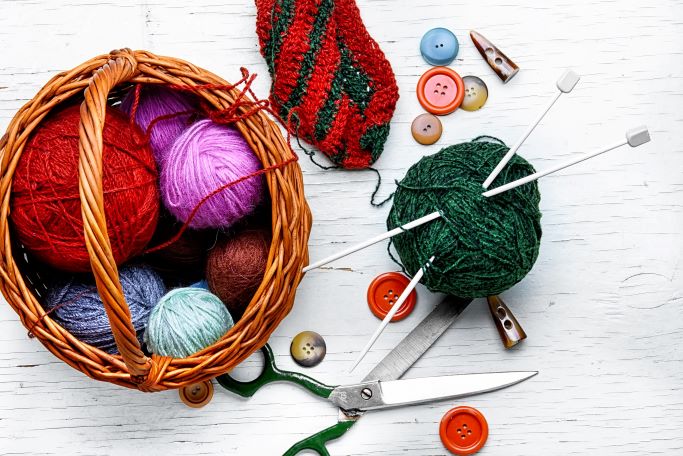
Knitting
Ah, knitting! It’s like a cozy hug from a fluffy ball of
Knitting is the art of creating fabric by interlocking loops of
Fun fact: knitting has been around for centuries, with origins dating back to the ancient times. Imagine all those crafty ancestors who paved the way for our knitting adventures today!
Materials and Tools Used in Knitting
- Yarn: Ah, the star of the show! Choose a
yarn that makes your heart flutter. Whether you prefer soft and squishy or vibrant and bold, there’s ayarn out there for everyone. Explore different fiber types like wool, cotton, or acrylic, and indulge in various colors and textures. Remember, theyarn is what brings your knitting projects to life! - Knitting Needles: These trusty companions come in a variety of materials and sizes. For beginners, I recommend starting with a pair of medium-sized needles, around US size 8 (5mm), as they work well with a range of
yarn weights. You can choose between straight needles, which are great for flat projects, or circular needles, which can handle both flat and circular knitting. - Scissors: A pair of sharp scissors is a must-have tool for any knitter. You’ll use them to snip
yarn ends, cut through stitch markers, or even free yourself from the occasional knitting tangle. Keep them handy in your knitting bag or project pouch. - Stitch Markers: These little helpers come in handy for marking specific stitches or sections in your knitting. They can be as simple as small plastic rings or fancy decorative ones. They’re especially useful for intricate patterns, ensuring you stay on track and avoid unraveling your hard work.
- Tapestry Needles: These blunt-ended needles are used for weaving in
yarn ends and seaming knitted pieces together. They make the finishing touches of your projects neat and tidy. Opt for ones with large eyes, so threading theyarn through them is a breeze. - Measuring Tape: To ensure your knitting projects turn out the right size, a measuring tape is essential. You can use it to measure gauge swatches, check the length of your knitted pieces, or determine the circumference of hats and garments.
- Row Counter: A row counter is a handy gadget that helps you keep track of your rows and rounds. It saves you from the confusion of losing count or constantly jotting down numbers. You can find physical counters or use digital ones on your smartphone or tablet.
- Knitting Bag or Project Pouch: Finally, you’ll want a dedicated space to keep all your knitting supplies organized and portable. Choose a bag or pouch that accommodates your
yarn , needles, and other accessories, with extra pockets for convenience.
Techniques and stitches specific to knitting
Let’s take a closer look at some of the techniques and stitches that are specific to knitting.
- Knit Stitch: The foundation of knitting, creating a smooth, v-shaped texture on the right side of the fabric.
- Purl Stitch: The counterpart to the knit stitch, producing a bumpy, horizontal texture on the right side of the fabric.
- Cables: Crossing stitches over each other to form intricate braided or twisted designs.
- Lace Knitting: Using
yarn overs and decreases to create delicate and airy patterns, often resembling leaves, flowers, or geometric shapes. - Colorwork: Incorporating multiple colors into knitting projects.a. Fair Isle: Working with two or more colors in a single row to create intricate patterns and motifs.b. Intarsia: Knitting separate blocks of color, ideal for bold and graphic designs.
- Entrelac: Creating a textured fabric with interconnected squares or diamonds.
- Brioche: A technique that produces a thick, reversible fabric with a ribbed texture.
- Stranded Knitting: Using multiple colors in the same row or round, with floats of unused color carried along the back of the work.
- Slip Stitch: Slipping stitches from the left needle to the right needle without knitting or purling them, creating texture and color patterns.
- Garter Stitch: A simple stitch pattern created by knitting every row, resulting in a ridged fabric.
- Seed Stitch: Alternating knit and purl stitches within a row or across rows, creating a textured, nubby fabric.
- Ribbing: Alternating knit and purl stitches in a specific pattern, often used for cuffs, collars, and edges to provide stretch and structure.
- Eyelets: Creating decorative holes by combining
yarn overs and decreases. - Mosaic Knitting: A colorwork technique that uses slipped stitches to create the appearance of complex patterns using only one color at a time.
- Double-Knitting: A technique that creates a double-sided fabric with two layers of knitting, often resulting in reversible patterns.
Characteristics of Knitted Items
As a passionate knitter, I’ve come to appreciate the unique characteristics that make knitted items truly special. When we knit, we create fabrics that possess distinct textures, drape, and elasticity, giving our handmade pieces a delightful touch. Let’s explore these charming characteristics in more detail:
- Texture: Knitted items often exhibit a rich and varied texture, thanks to the combination of different stitches and techniques. From the smooth and uniform surface of stockinette stitch to the raised ridges of garter stitch, each stitch pattern contributes to the overall texture of the fabric. This textured quality adds depth and interest to our knitted creations, making them visually captivating and enjoyable to touch.
- Drape: One of the remarkable qualities of knitted fabrics is their drape. Depending on the
yarn chosen and the stitch pattern used, knitted items can have a flowing and graceful drape or a more structured and substantial one. Fabrics with excellent drape effortlessly cascade and follow the contours of the body, making them ideal for creating elegant garments such as flowing cardigans or ethereal shawls. - Elasticity: Knitted fabrics have a natural elasticity, allowing them to stretch and return to their original shape. This elasticity is particularly valuable in garments that require flexibility and a snug fit, like socks, hats, and gloves. The unique construction of knitted stitches allows the fabric to stretch comfortably without losing its shape, providing both comfort and durability.
- Warmth: Knitted items have an inherent warmth that comes from the nature of the craft itself. The structure of knitted fabric creates tiny air pockets, which act as insulators, trapping heat and providing coziness. This makes knitted pieces perfect for winter accessories like scarves, mittens, and sweaters, keeping us warm and snug during chilly weather.
- Versatility: Knitted fabrics are incredibly versatile, adapting to a wide range of projects and styles. Whether you’re knitting a chunky blanket for cozy evenings or a delicate lace shawl for a special occasion, the versatility of knitted fabrics allows you to explore various designs and adapt to different purposes. The ability to customize the thickness, stitch pattern, and fiber choice gives you endless creative possibilities.
Pros and Cons of Knitting
I’ve discovered both the joys and challenges that come with this beloved craft. Knitting offers a multitude of benefits, but it’s not without its drawbacks. Let’s explore the pros and cons of knitting from my perspective:
Pros of Knitting:
- Creativity Unleashed: Knitting provides an outlet for my creative expression. With countless stitch patterns, color combinations, and
yarn choices, the possibilities are endless. I can bring my unique vision to life and create one-of-a-kind pieces that reflect my personal style. - Relaxation and Mindfulness: Knitting has a soothing and calming effect on my mind. The repetitive motion of the needles, the soft clickety-clack, and the gentle rhythm help me unwind and find peace in the present moment. It’s a wonderful way to relieve stress and practice mindfulness.
- Portable and Convenient: One of the great advantages of knitting is its portability. I can take my project anywhere, whether it’s a long commute, a cozy café, or a park bench. It fills idle moments with productivity and allows me to make progress on my projects wherever I go.
- Handmade with Love: Knitted items hold a special place in the hearts of both the creator and the recipient. Handmade gifts are imbued with love, care, and thoughtfulness. They carry a personal touch that can’t be replicated by store-bought items, making them truly cherished and meaningful.
- Community and Connection: Knitting has introduced me to a vibrant community of fellow crafters. Whether through knitting circles, online forums, or social media groups, I’ve found a sense of belonging and camaraderie. Sharing ideas, patterns, and experiences with like-minded individuals is incredibly inspiring and uplifting.
Cons of Knitting:
- Time-Consuming: Knitting is not known for its speed. Projects can take a significant amount of time to complete, especially larger or intricate ones. Patience is key, as it requires dedication and commitment to see a project through to the end.
- Learning Curve: Like any skill, knitting has a learning curve. Mastering various stitches, techniques, and patterns takes time and practice. It’s important to be patient with yourself and embrace mistakes as learning opportunities along the way.
- Complexity and Frustration: Some knitting projects can be quite complex and challenging. Patterns with intricate stitch work or intricate construction may require extra attention and focus. Mistakes can happen, and unraveling or fixing them can be frustrating at times. However, the satisfaction of overcoming challenges and completing a project is immensely rewarding.
- Cost: Knitting can become an expensive hobby, especially when using high-quality yarns and investing in specialized tools. It’s essential to budget and prioritize, finding a balance between splurging on luxurious fibers and making the most of affordable options.
- Limited Stretch: Knitted fabrics, while elastic, have a natural limit to their stretch. This can affect the fit of garments, requiring careful measurements and adjustments to ensure a proper fit. Selecting the appropriate
yarn and gauge is crucial to achieving the desired outcome.
In spite of these challenges, the joys of knitting far outweigh the cons for me. The satisfaction of creating something beautiful and the sense of accomplishment that comes with each finished project make it all worthwhile. Knitting brings me joy, relaxation, and a deep sense of fulfillment that keeps me coming back for more.
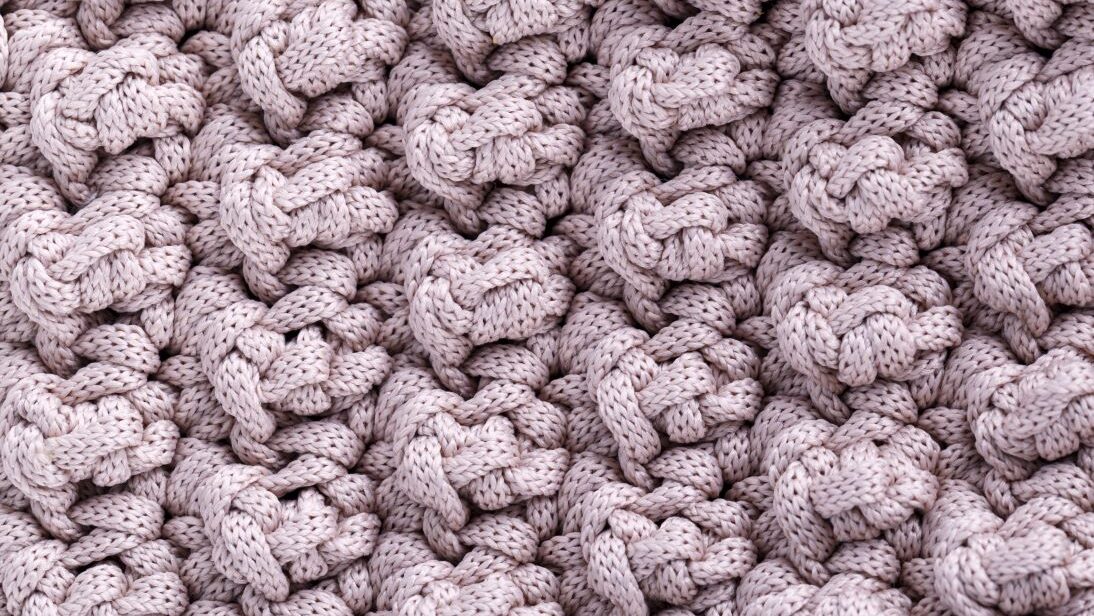
Crochet
As a crocheter, I adore the art of creating fabric with a single hook and
Materials and Tools Used in Crochet
Here’s a list of materials and tools commonly used in crochet:
- Crochet Hooks: These come in various sizes and are used to create loops and stitches. They can be made of different materials such as aluminum, steel, plastic, or wood, each offering a different feel and grip.
- Yarn:
Yarn is the primary material used in crochet. It comes in a wide variety of fibers, weights, colors, and textures. Choose theyarn that best suits your project, whether it’s cotton for lightweight summer garments or acrylic for cozy blankets. - Stitch Markers: These are used to mark specific stitches or sections in your crochet work. They come in different forms, such as locking stitch markers or simple loop markers, and help you keep track of your progress and pattern repeats.
- Yarn Needles: Also known as tapestry needles, these large-eyed needles are used to weave in loose ends, sew pieces together, and finish off your crochet projects neatly.
- Scissors: A pair of sharp scissors is essential for cutting
yarn and trimming loose ends. - Measuring Tape: Use a flexible measuring tape to accurately measure your work, check gauge, or ensure proper sizing for your projects.
- Stitch Holders or Safety Pins: These are helpful for holding stitches in place when working on intricate patterns, color changes, or when setting aside work in progress.
- Row Counter: A row counter is a useful tool for keeping track of the number of rows completed in your project, especially in larger or more complex patterns.
- Blocking Tools: Blocking mats, pins, and blocking wires are used to shape and stretch your finished crochet pieces, ensuring they lay flat and achieve the desired dimensions.
- Pattern Books or Online Resources: Whether in physical form or online, pattern books and resources are valuable for finding inspiration, learning new stitches, and following step-by-step instructions for various crochet projects.
Techniques and Stitches Specific to Crochet
Now lets dive into some of the techniques and stitches that are specific to crochet:
- Chain Stitch (ch): The chain stitch is the foundation of crochet. It forms a series of interlocking loops and serves as the starting point for most crochet projects.
- Single Crochet (sc): This stitch creates a dense fabric and is often used for amigurumi, solid garments, or adding texture to projects.
- Half Double Crochet (hdc): The half double crochet stitch is taller than a single crochet but shorter than a double crochet. It works up quickly and is often used for blankets, scarves, and hats.
- Double Crochet (dc): The double crochet stitch is versatile and creates a taller stitch. It’s commonly used in a variety of projects, including blankets, garments, and accessories.
- Treble Crochet (tr): The treble crochet stitch is even taller than the double crochet. It’s often used for lacy patterns, shawls, or projects that require an open and airy texture.
- Slip Stitch (sl st): The slip stitch is a simple and versatile stitch used for joining rounds, creating decorative edges, or making smooth transitions between different parts of a project.
- Magic Ring (or Magic Circle): The magic ring technique is used to start crocheting in the round, providing a tight and adjustable center for projects like hats, amigurumi, or mandalas.
- Popcorn Stitch: The popcorn stitch creates a raised, bumpy texture by working multiple stitches into the same stitch and then securing them together. It’s often used to add dimension and visual interest to blankets or accessories.
- Shell Stitch: The shell stitch consists of a group of stitches worked in the same stitch or space, creating a shell-like pattern. It’s commonly used in lacework, shawls, and decorative edgings.
- Filet Crochet: Filet crochet involves creating a grid-like fabric with solid and open spaces. It’s often used for intricate designs, patterns, or pictorial representations.
- Tunisian Crochet: Tunisian crochet combines elements of both knitting and crochet. It uses a special long hook and produces a fabric that resembles a mix of knitting and crochet stitches. Tunisian crochet is popular for creating blankets, scarves, and textured garments.
These are just a few examples of the many techniques and stitches available in crochet. Experimenting with different stitches and techniques will open up a world of possibilities, allowing you to create unique and beautiful projects.
Characteristics of Croched Items (texture, structure, versatility)
As a passionate crocheter, I love exploring the unique characteristics that crocheted items possess. Here’s my perspective on the texture, structure, and versatility of crocheted creations:
Texture: One of the defining features of crocheted items is their texture. The interlocking loops and stitches create a fabric with a distinct texture that can range from smooth and tight to lacy and open. This texture adds depth and visual interest to projects, making them visually appealing and engaging to touch. I enjoy the tactile nature of crocheted items, whether it’s the cozy softness of a blanket or the intricate patterns that come to life through different stitch combinations.
Structure: Crocheted items often exhibit a sturdy and well-defined structure. The tightly worked stitches contribute to the overall durability of the fabric, making crocheted pieces long-lasting and resilient. This quality is particularly advantageous for items like bags, hats, or amigurumi, where a more structured form is desired. I find that the inherent structure of crochet allows me to create three-dimensional shapes and designs, bringing my imagination to life in a tangible way.
Versatility: Crochet offers tremendous versatility in terms of project possibilities. I can create a wide range of items, from intricate lace shawls and delicate doilies to cozy blankets and garments. The adaptability of crochet enables me to experiment with different
Moreover, crocheted items can be customized easily to fit specific needs. I can adjust the size, shape, or even stitch pattern to create personalized pieces that reflect my style and preferences. This versatility encourages creativity and allows for endless possibilities when it comes to crocheting.
In summary, crocheted items possess a distinct texture that adds visual and tactile appeal to projects. The sturdy structure of crochet ensures durability and longevity, making them well-suited for various applications. The versatility of crochet allows me to explore different styles, stitch patterns, and
Pros and Cons of Crochet
Pros of Crochet
- Creativity and Versatility: Crochet allows me to unleash my creativity and create unique, personalized pieces. I have the freedom to choose from a wide range of stitches, patterns, and yarns, enabling me to bring my vision to life and make one-of-a-kind creations.
- Portability and Convenience: Crochet is a highly portable craft. I can easily take my project with me wherever I go, whether it’s during my daily commute, traveling, or simply relaxing at a coffee shop. It’s a convenient craft that doesn’t require large equipment or extensive setup.
- Quick Results: Crocheting often yields quicker results compared to other crafts. With larger hooks and thicker yarns, projects can work up speedily, giving me the satisfaction of seeing progress and finished pieces sooner.
- Texture and Structure: I appreciate the unique texture and structure that crochet offers. The interlocking loops and stitches create fabrics with depth and character. The tightly worked stitches provide durability, making crocheted items long-lasting and well-suited for various applications.
- Relaxation and Mindfulness: Crocheting has a soothing and meditative quality. It helps me relax, destress, and find a sense of calmness. The repetitive motion of the hook and
yarn allows me to focus on the present moment and experience a mindful state of being.
Cons of Crochet
- Limited Drape and Elasticity: Compared to knitting, crochet fabric may have less drape and elasticity. This can affect the fit and flow of certain garments or projects that require a more fluid or stretchy fabric. However, with careful pattern selection and appropriate
yarn choices, this limitation can be minimized. - Fewer Stitch Options: While crochet offers a wide variety of stitches and techniques, it may have relatively fewer options compared to knitting. This can limit the complexity or variety of textures that can be achieved in crocheted projects. However, the abundance of available stitches still provides ample room for creativity and exploration.
- Learning Curve: Like any craft, crochet has a learning curve. Getting comfortable with holding the hook, understanding different stitch techniques, and reading patterns may take some practice and patience. However, with time and dedication, the learning process becomes enjoyable and rewarding.
- Yarn Consumption: Crochet generally requires more
yarn compared to knitting due to its thicker stitches and dense fabric. This can result in higheryarn consumption and potentially higher project costs. However, this can be managed by selecting yarns that fit within your budget and planning projects accordingly. - Fit and Sizing Considerations: Achieving precise fit and sizing in crochet projects may require additional attention and adjustments. Since crochet fabric is less stretchy than knitted fabric, it’s important to carefully follow pattern instructions, swatch, and consider gauge to ensure the desired fit and measurements.
Overall, the pros of crochet, such as creativity, portability, quick results, and unique texture, outweigh the cons.
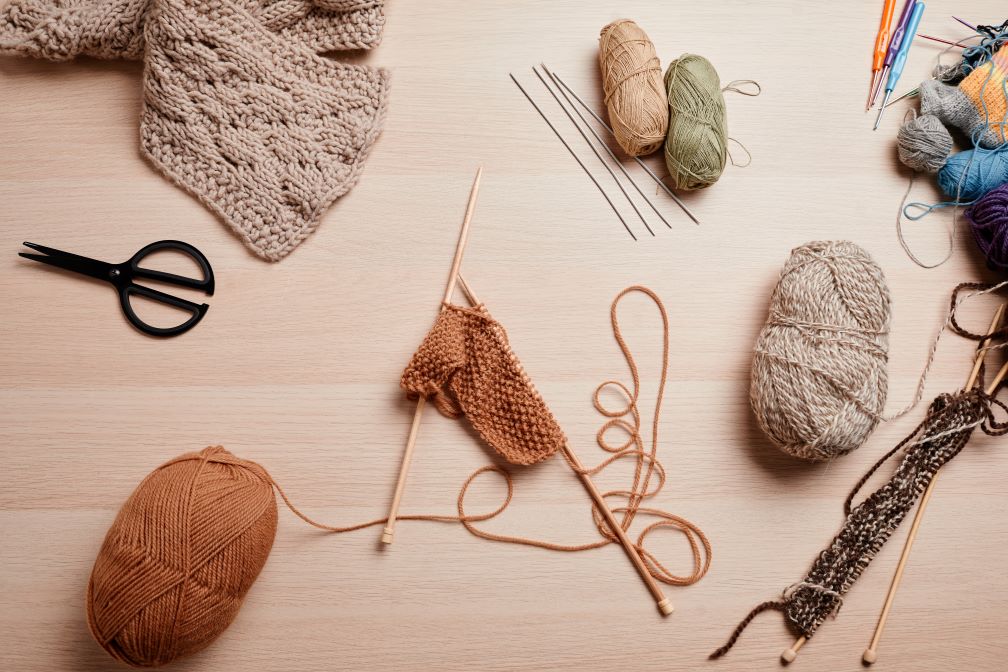
Breaking Down the Differences: Knit vs Crochet
Technique
Knitting: Knitting involves using two or more needles to create interlocking loops of
Crochet: Crochet, on the other hand, uses a single hook to create loops and stitches. The hook is used to pull the
In summary, knitting involves using two or more needles to create interlocking loops, while crochet uses a single hook to create loops and stitches.
Tools
Knitting: Knitting requires the use of two or more knitting needles, typically made of metal, wood, or plastic. Knitting needles come in various sizes, lengths, and styles, such as straight needles, circular needles, or double-pointed needles. The choice of needles depends on the specific project and desired outcome.
Crochet: Crochet is done using a single crochet hook. Crochet hooks are available in different sizes and materials, such as aluminum, plastic, or bamboo. The size of the hook determines the size and tension of the stitches. Crochet hooks have a hooked or curved end that allows the
In summary, knitting requires the use of two or more knitting needles, while crochet is done using a single crochet hook
Speed and Efficiency
Knitting: Knitting tends to be slower compared to crochet due to the nature of the technique. The use of multiple needles and the process of manipulating and transferring stitches can require more time and effort. However, knitting can cover a larger area with fewer stitches, making it more efficient when working on projects with larger, smoother surfaces.
Crochet: Crochet is generally faster compared to knitting because it involves working with a single hook and completing one stitch at a time. The smaller, more compact stitches in crochet allow for quicker progress. However, crochet may require more stitches to cover the same area as knitting, making it less efficient for projects with larger surface areas.
In summary, knitting is generally slower but more efficient in terms of coverage, while crochet is faster but may require more stitches to achieve the same coverage.
Versatility
Knitting: Knitting offers a high level of versatility in terms of stitch patterns and design possibilities. It excels at creating intricate textures, complex stitch patterns, and detailed colorwork. Knitting allows for the creation of various fabric structures, such as cables, lace, and fair isle designs. It is well-suited for projects that require a smooth, draping fabric with a more refined appearance.
Crochet: Crochet is highly versatile in terms of creating three-dimensional shapes, textured fabrics, and intricate lacework. It offers the flexibility to work stitches in different directions, allowing for the creation of more sculptural designs and embellishments. Crochet is known for its ability to produce thicker, sturdier fabrics, making it suitable for items like blankets, amigurumi, and accessories.
In summary, knitting excels in intricate stitch patterns, colorwork, and creating smooth, draping fabrics, while crochet shines in three-dimensional shapes, textured fabrics, and sculptural designs.
Learning Curve
Knitting: Knitting has a steeper learning curve compared to crochet, especially for beginners. It involves coordinating two or more needles and working with multiple stitches at once. Learning how to hold the needles, tension the
Crochet: Crochet has a relatively easier learning curve, making it more accessible for beginners. With only one hook and simpler stitch techniques, it’s easier to get started with crochet. Beginners can quickly learn basic stitches like the chain, single crochet, and double crochet. Crochet patterns are often written with more detailed instructions, making it easier to follow along.
In summary, knitting has a steeper learning curve with the coordination of multiple needles and more complex patterns, while crochet has a relatively easier learning curve with its single hook and simpler stitch techniques.
How to Choose Between Knit and Crochet
When deciding between knitting and crochet, it’s important to consider your desired project outcomes, preferred textures, and overall aesthetic. Think about the types of items you want to create, the level of intricacy you’re comfortable with, and the fabric characteristics you prefer. Some projects may lend themselves better to knitting, while others may be more suited for crochet. Remember, there are no hard and fast rules, and you can always explore and experiment with both techniques to find the one that aligns with your creative vision.
Here are some key points to consider:
- Project Outcomes: Think about the types of items you want to create. Knitting excels in creating smooth, draping fabrics and intricate stitch patterns, making it ideal for garments, shawls, and delicate lacework. Crochet, on the other hand, allows for three-dimensional shapes, textured fabrics, and sculptural designs, making it great for items like blankets, amigurumi, and accessories.
- Textures: Consider the textures you prefer in your projects. Knitting produces a smoother, more refined fabric, while crochet often results in thicker, more textured fabrics. If you enjoy intricate stitch patterns and a polished look, knitting may be the way to go. If you’re drawn to textured or chunky designs, crochet might be more suitable.
- Aesthetic Appeal: Reflect on your overall aesthetic preferences. Knitting offers a classic, timeless appeal with its intricate designs and elegant drape. Crochet, on the other hand, has a more playful and versatile aesthetic, with its ability to create unique shapes and textures. Consider the look and feel you want to achieve in your finished pieces.
Summary of Differences Between Crochet vs Knitting
Here’s a handy table that gives you a sneak peek into the exciting differences between crochet and knitting. Keep in mind that these traits are general, but both crafts open up a world of creativity. So, feel free to dive into the wonderful realm of crochet and knitting, and let your imagination run wild!
| Category | Crochet | Knitting |
|---|---|---|
| Technique | Uses a single crochet hook | Uses two or more knitting needles |
| Fabric Creation | Interlocking loops | Interlocking rows of stitches |
| Yarn Weight | Generally uses thicker | Can use a wide range of |
| Stitch Characteristics | Taller stitches with more texture | Shorter stitches with smoother appearance |
| Fabric Properties | More sculptural and 3D possibilities | Fluid drape and stretchiness |
| Speed | Works up faster due to larger stitches | Can be slower due to smaller stitches |
| Project Types | Versatile for creating intricate designs | Great for creating structured and fitted garments |
| Mistake Correction | Easy to fix mistakes with individual stitches | Easier to unravel and fix mistakes in rows |
| Stitch Variety | Less emphasis on stitch patterns | Wide variety of stitch patterns and charts |
| Application | More suitable for amigurumi and detailed embellishments | Well-suited for garments, accessories, and lacework |
Remember, this table is just a glimpse of the magic that awaits you in the world of crochet and knitting. Don’t be afraid to mix and match, experiment, and let your creativity soar! Whether you choose the hook or the needles, embrace the joy of crafting and have a blast!
What Items Are Best Made with Knitting vs Crochet?
| Item | Knitting | Crochet |
|---|---|---|
| Sweaters | ✔️ | ✔️ |
| Scarves | ✔️ | ✔️ |
| Hats | ✔️ | ✔️ |
| Socks | ✔️ | ❌ (Rare, but possible) |
| Shawls | ✔️ | ✔️ |
| Blankets | ✔️ | ✔️ |
| Amigurumi/Toys | ❌ (Possible, but less common) | ✔️ |
| Lacework | ✔️ | ✔️ |
| Dishcloths | ❌ (Uncommon) | ✔️ |
| Tote Bags | ❌ (Uncommon) | ✔️ |
| Baby Booties | ✔️ | ✔️ |
| Sweater Vests | ✔️ | ❌ (Uncommon) |
| Leg Warmers | ✔️ | ❌ (Uncommon) |
| Teddies | ❌ (Uncommon) | ✔️ |
| Stuffed Animals | ❌ (Uncommon) | ✔️ |
| Doll Clothes | ✔️ | ❌ (Uncommon) |
Knitting vs Crochet Pros and Cons
Knitting
Pros
- Silky texture and excellent drape for elegant projects.
- Worsted weight offers versatility for various designs.
- Wide range of colors to choose from.
- Machine washable and dryer safe for easy care.
- Glides smoothly through the Sentro knitting machine.
Cons
- May lack the warmth of wool-based yarns.
- Requires proper tension adjustments for optimal stitch formation.
Crochet
Pros
- Silky texture and excellent drape for elegant projects.
- Worsted weight offers versatility for various designs.
- Wide range of colors to choose from.
- Machine washable and dryer safe for easy care.
- Glides smoothly through the Sentro knitting machine.
Cons
- May lack the warmth of wool-based yarns.
- Requires proper tension adjustments for optimal stitch formation.
My Opinion: Knit or Crochet?
Knitting
As a knitter, I love the versatility knitting offers for a wide range of projects. From cozy sweaters to intricate lace shawls, the stitch patterns and techniques in knitting allow me to explore endless creative possibilities. I appreciate the smooth, polished appearance that knitting provides, creating a professional look in my projects. The drape and elasticity of knitted fabrics are ideal for achieving a comfortable fit and some stretch in garments like socks or fitted tops. I also enjoy the variety of stitch patterns available in knitting, such as cables, lace, and colorwork, allowing me to create intricate textures and visually stunning designs.
While I appreciate the versatility of knitting, I understand that it has a steeper learning curve, especially for beginners. Working with multiple needles, mastering various stitch techniques, and understanding pattern instructions can be challenging at first. Additionally, knitting projects can be time-consuming, especially larger ones, due to the nature of the craft and the finer gauge of stitches. Patience and dedication are essential to see these projects through to completion.
Crochet
As a crocheter, I enjoy the quick results that crochet provides. With just a single hook and thicker
Despite the many advantages of crochet, I acknowledge that it may have some limitations. Crochet fabrics tend to have less drape and elasticity compared to knitted fabrics, which may not be suitable for garments that require a flowy or stretchy fit. The thicker and more textured look of crochet stitches may also result in a chunkier appearance, which may not align with everyone’s aesthetic preferences or desired project outcome. Additionally, while crochet offers a variety of stitch patterns, it generally has fewer options compared to knitting, limiting the complexity or variety of textures that can be achieved.
Remember, these perspectives are based on my personal experience as a knitter and crocheter. Individual preferences, project goals, and desired outcomes may vary. Consider these factors when deciding which craft suits you best. Enjoy the journey of creating beautiful and meaningful handmade items!
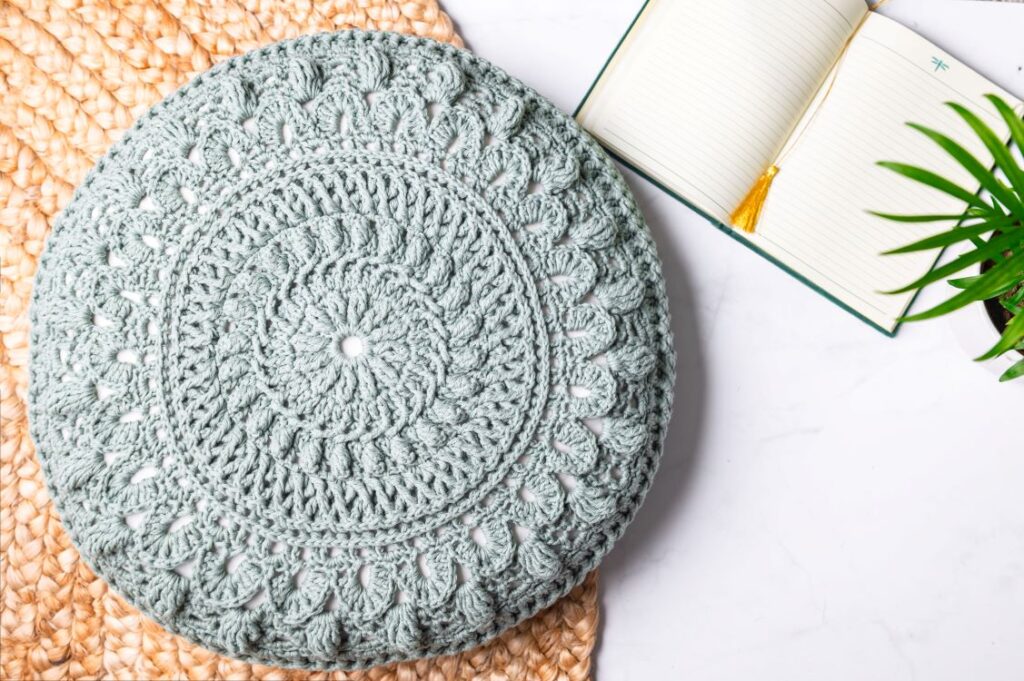
Wrapping It All Together
In this journey exploring the differences between knitting and crochet, we have discovered the distinctions in techniques, tools, speed, versatility, learning curve, and personal preference. We have seen how knitting offers intricate stitch patterns and smooth, draping fabrics, while crochet provides the ability to create three-dimensional shapes and textured designs.
I encourage you to dive into the world of both knitting and crochet. Don’t be afraid to pick up the needles and hooks, practice the stitches, and explore the vast array of patterns and techniques available. Allow yourself to experiment and discover the unique possibilities each craft has to offer. You might be pleasantly surprised by what you can create!
When it comes to choosing between knitting and crochet, remember that there is no one-size-fits-all answer. Consider your desired project outcomes, preferred textures, and overall aesthetic. Reflect on your personal goals and the satisfaction you derive from each craft. Ultimately, the decision should align with your creative vision and bring you joy in the process.
So, whether you find yourself drawn to the rhythmic dance of knitting needles or the gentle flow of a crochet hook, embrace the opportunity to explore both crafts. Each has its own unique charm and endless possibilities waiting to be discovered. The key is to make an informed choice based on your personal preferences and goals.
Happy knitting and crocheting, and may your creative journey be filled with joy, inspiration, and beautiful handmade creations!
- Master Crochet Stitches for Cozy Creations - January 23, 2024
- Half Double Crochet Guide for Cozy Creations - January 23, 2024
- Elevate Your Space with Unique Macrame Creations - January 23, 2024

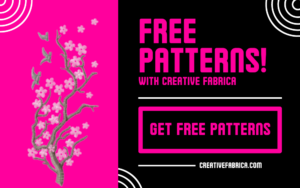
Hi there to every body, it’s my first visit of this blog; this website includes
awesome and actually good material in favor of visitors.